PIONEER DDJ-XP2

INSTALLATION
Firmware & Drivers
Firmware: At the time this manual was written there are no firmware updates available for Pioneer DDJ-XP2. However always check Pioneer Dj website for any firmware updates.
Drivers: No drivers are required for the Pioneer DDJ-XP2 to operate. The device is a USB class compliant and your Operating System will auto-install the necessary drivers when connected with a USB cable.
Download and install VirtualDJ 2020 from our Downloads Page
(in case you have not done already)
Once VirtualDJ 2020 is launched, a Login Window will appear. Please login with your preferred method from the ones provided.
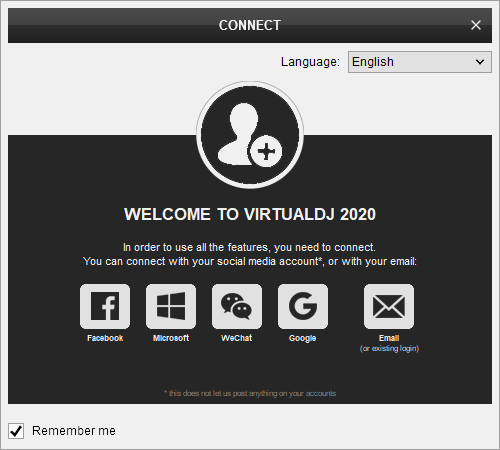
A Pro Infinity, a Pro Subscription or a DDJ-XP2 Plus License is required to fully use the Pioneer DDJ-XP2.
Without any of the above Licenses, the controller will operate for 10 minutes each time you restart VirtualDJ.
Buy a license
Click to OK.
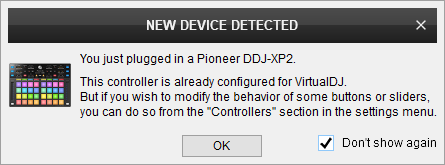
MIDI Operation
The unit should be visible in the CONTROLLERS tab of Config and the “factory default” should be available/selected from the Mappings drop-down list. The factory default Mapping offers the functions described in this Manual, however those can be adjusted to your needs via VDJ Script actions.
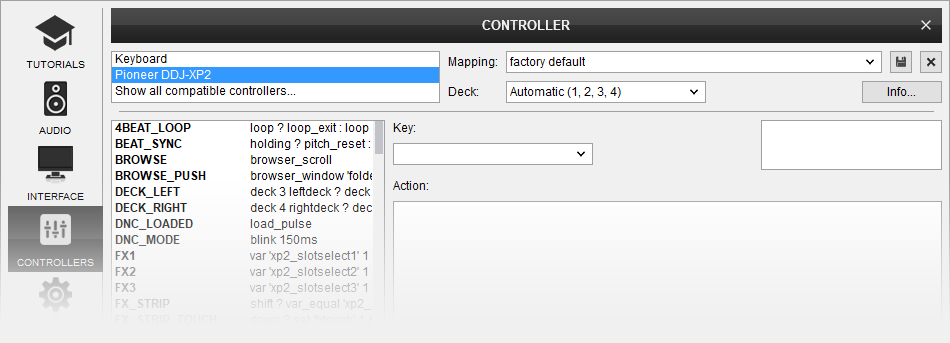
Find more details at VDJ Pedia
AUDIO Setup
The unit is not offering any pre-defined audio configuration, as no built-in audio interface is available. Depending on the sound card you need to use, manually create the necessary Master and Headphones audio configuration.
By default VirtualDJ 8 will send the Master Output to the built-in (default) sound card of your computer.
For further software settings please refer to the Manuals of VirtualDJ 2020
LAYOUT
S SHIFT: Hold this button down to access secondary functions of Pioneer DDJ-XP2 (mainly in black lettering inside a gray box)
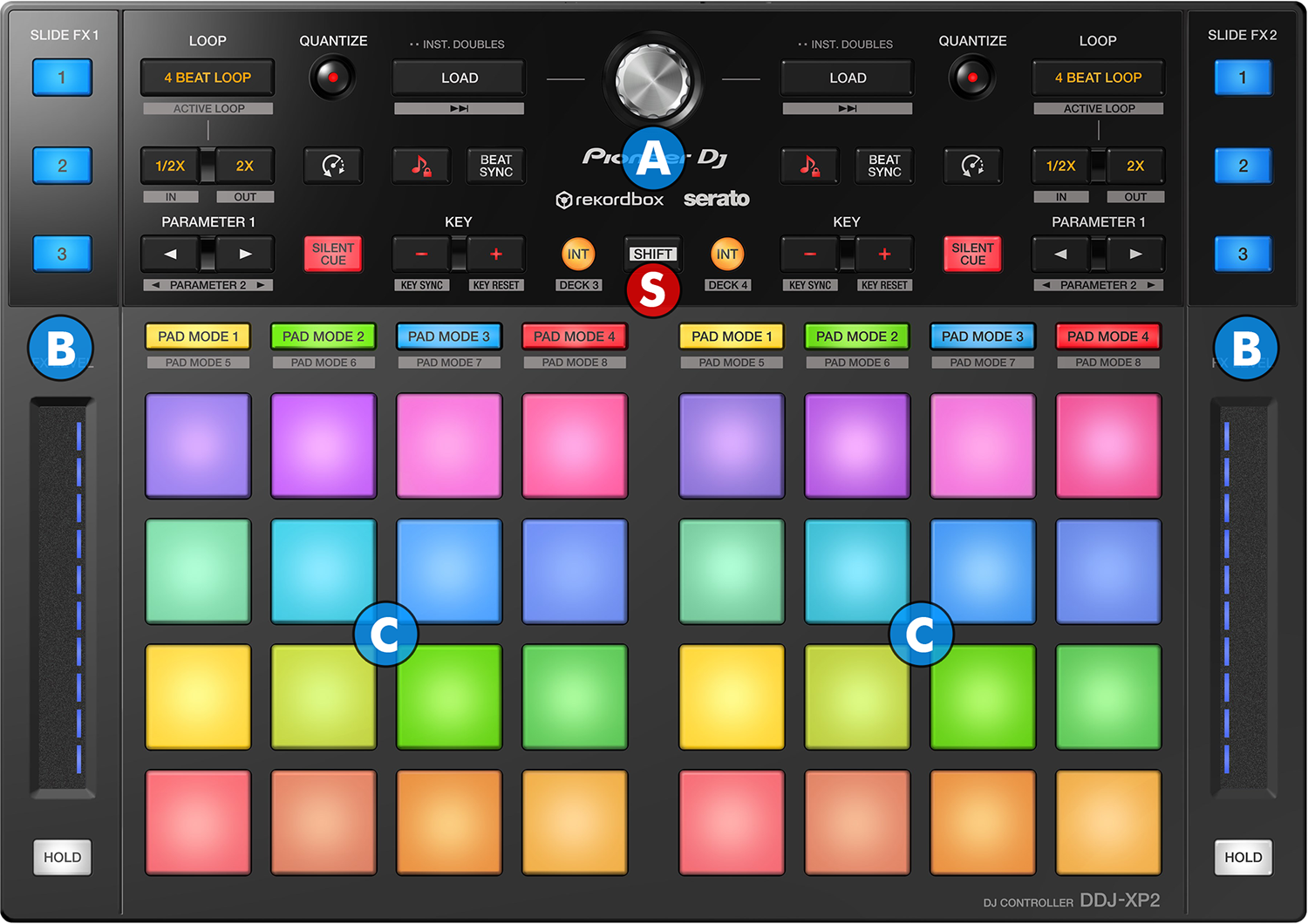
The functionality of each button, knob and slider per section (as shown in the image above) will be explained in detail in the next chapters:
CONTROLS

- 4BEAT LOOP: When no loop is active, enables a Loop of 4 Beats at the current position. When any loop is active, it exits the Loop.
Hold SHIFT and then press this button to save a Loop at the current position. Hold SHIFT and then hold the same button for more than 1 second, to delete the Saved Loop. - 1/2X: Halve the size of the active loop (if a loop is active) or the default auto loop (when no loop is active)
When no loop is active, hold SHIFT down and use this button to set current track's position as the start position of a manual loop. - 2X: Double the size of the active loop (if a loop is active) or the default auto loop (when no loop is active)
When no loop is active, hold SHIFT down and use this button to set current track's position as the end position of a manual loop (and start looping). - QUANTIZE: When enabled, Hotcues and Loops will be snapped to the nearest beat/size (or other value depending on the setting globalQuantize - from VDJ Settings->OPTIONS tab)
- SLIP REVERSE: Press and hold this button to play the track backwards. On release the track will resume playing from the position it would have been if the button was never pressed.
Hold SHIFT down and press this button to activate reverse playback. Press again to restore normal (forwards) direction. The track will resume playing from it's current position - SILENT CUE: Press this button to mute the sound of the deck. Press once again or use any of the hotcue pads to restore the sound.
- LOAD: Press this button to load the selected track from the Browser to the Left/Right Deck.
Double-press to clone/copy the opposite Deck to the Left/Right Deck
Hold SHIFT down and then use the button to load the next track from the Browser - MASTER TEMPO: Press this button to enable/disable the Master Tempo (Key Lock) of the deck.
Hold SHIFT down and then use the button to change the available pitch range between 8%, 16% and 50% - BEAT SYNC: Press this button to sync the BPM and phase of the deck with the opposite one. Hold the same button for more than 1 second to reset the BPM/Tempo of the track to its original value.
Hold SHIFT down and then press this button to set the deck as Master Deck. When using 4 decks skins, all other decks will sync to the Master Deck.
Hold SHIFT down and then press this button for more than 1 second to restore automatic selection of Master Deck (VirtualDJ will automatically determine which deck is Master by using various parameters). - KEY SEMITONE - : Use this button to decrease the key of the track by 1 semitone.
Hold SHIFT down and then use this button to match the key of the track with the key of the opposite deck. - KEY SEMITONE + : Use this button to increase the key of the track by 1 semitone.
Hold SHIFT down and then use this button to reset the key of the track to its original value. - INT: Press this button to enable/disable Timecode input (if set in Audio Setup). The led of the button will turn on when no timecode input is used (Internal Clock)
Hold SHIFT and then press the left INT button to set Deck 1 or Deck 3 as Left Deck.
Hold SHIFT and then press the right INT button to set Deck 2 or Deck 4 as Right Deck.
All controls and functions on the DDJ-XP2 will apply to the selected Left/Right Deck. - BROWSE: Use this encoder to scroll through files or folders in the selected Browser list.
If focus is on the Songs or Sideview window, push the encoder to set focus to the Folders list.
If focus is on the Folders list, push the encoder to set focus to the Songs List (if folder has tracks), or expand its sub-folders and focus the 1st sub-folder available.
Hold SHIFT down and then push the encoder to open/close sub-folders (if available)
All controls and functions on the DDJ-XP2 will apply to the selected Left/Right Deck.
EFFECTS

- FX1: When enabled (LED lit), the FX LEVEL touch-strip will apply on the selected Effect of FX Slot 1.
Hold SHIFT down and then use this button to select the next available Effect for the FX Slot 1 - FX2: When enabled (LED lit), the FX LEVEL touch-strip will apply on the selected Effect of FX Slot 2.
Hold SHIFT down and then use this button to select the next available Effect for the FX Slot 2 - FX3: When enabled (LED lit), the FX LEVEL touch-strip will apply on the selected Effect of FX Slot 3.
Hold SHIFT down and then use this button to select the next available Effect for the FX Slot 3 - FX LEVEL: Touch and slide this touch-strip to adjust the 1st Parameter of the selected FX Slot(s) and activate the Effect(s), as long as the touch-strip is held.
- HOLD: When enabled, the Effect(s) will remain active after the touch-strip is released. Press this button again to turn the effect(s) off.
Notes :
- When no FX Slot is selected, the LEDs of the FX1, FX2 and FX3 buttons will flash if the touch-strip is used, indicating that at least one FX Slot needs to be selected.
- When more than one FX Slots are selected the level of the effect is the same for all effects
- When more than one FX Slots are selected the order of activation (chain effects) is always FX Slot 1, then FX Slot 2, then FX Slot 3
PADS
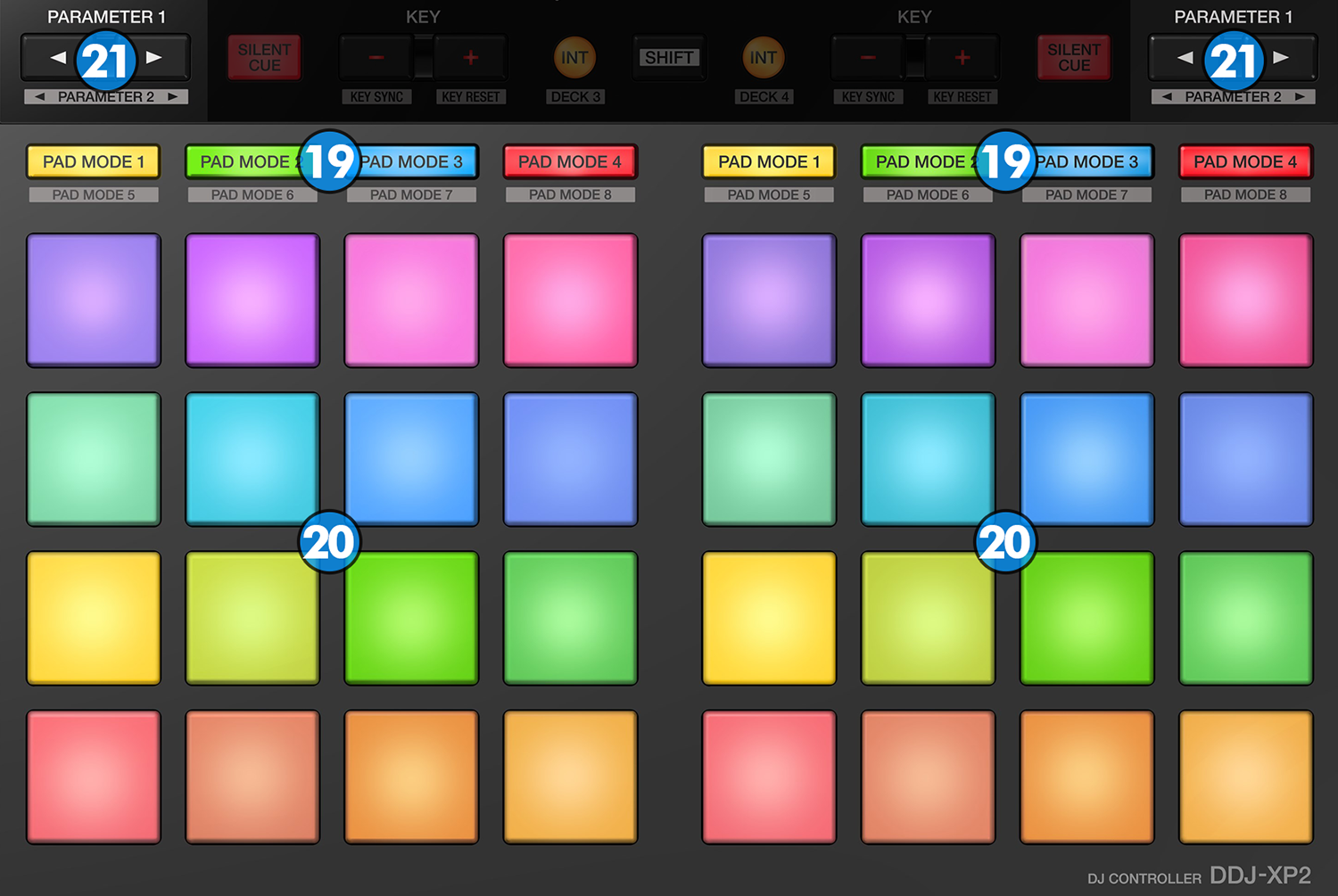
All controls and functions on the DDJ-XP2 will apply to the selected Left/Right Deck.
- PAD MODE: Use these 4 buttons to select a mode for the Pads. Hold SHIFT button down and then use the same buttons to select an additional/secondary mode for the Pads. 8 Modes in total are available and can be selected individually per deck/side.
Each time a mode is selected, the related Pads page will be automatically loaded to the default GUI of VirtualDJ.
Press the same PAD MODE button again to toggle the Pads view on the GUI between the view of Pads 1-8 and Pads 9-16 - PADS: The 16 RGB colored Pads perform different functions, depending on the selected Pad mode. See next chapters for further details
- PARAMETER: Use these buttons to control the 1st Parameter of the selected mode (if available). Hold SHIFT button down and then use these buttons to control the 2nd Parameter of the selected mode (if available). The functionality of the Parameters depend on the selected mode. See next Chapters for further details.
HOTCUES
Press the PAD MODE 1 button to set the PADs to Hot Cue mode.
Each one of the 16 pad assigns a Hot Cue Point (1 to 16) or jumps the track to that Hot Cue Point (if assigned).
When a Hot Cue Button is unlit, you can assign a Hot Cue Point by pressing it at the desired point in your track. Once it is assigned, the Hot Cue Button will light on.
The color of the Pad depends on the setting nonColoredPOI or the assigned color from the POI Editor.
Hold SHIFT button down and then press a pad to delete its assigned Hot Cue Point.
Use the PARAMETER buttons to jump the song to the previous/next assigned HotCue point.
LOOP ROLL & SLICER
Press the PAD MODE 2 button to set the PADs to Loop Roll & Slicer mode.
In this mode the pads of each deck are divided to two groups:
The upper two rows (pads 1-8) operate Loop Rolls, and the lower two rows (pads 9-16) operate the Slicer.
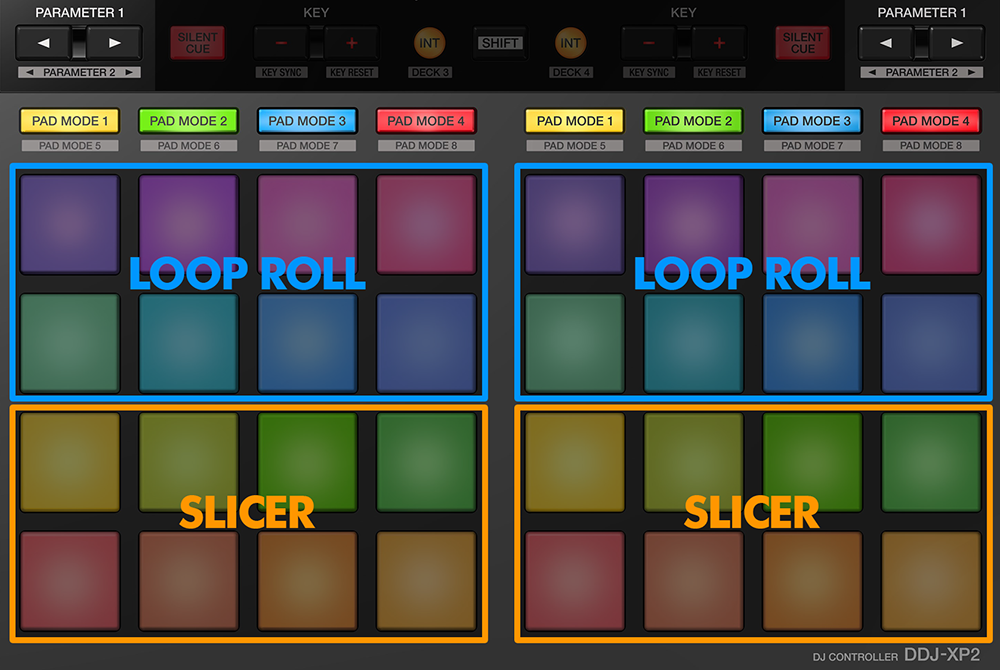
Press one of the 8 upper pads to trigger a momentary Loop Roll. Once the Pad is released, the track will resume playing from the position it would have been if the Loop Roll was never triggered. The exit point will be visible on the waveform of the VirtualDJ GUI with an additional “running” play marker.
Hold SHIFT button down to get ½, ¾, 1 and 2 beats Loop Roll sizes for the 4 pads on the second row.
Use the Page menu to apply the Loop Rolls to Video.
The 8 lower pads represent eight sequential beats—"Slices"—in the Beat Grid. The currently playing Slice is represented by the currently green lit pad. The light will move through the pads as it progresses through each eight-Slice phrase. Press a pad to repeat that Slice (hold it down if you want to keep looping it).
Once the Pad is released the track will continue to play from the position it would have been if the pad was never pressed.
Hold SHIFT button down and then use the Pads to repeat the memorized Slices (the Slices played/repeated last time)
Use the PARAMETER buttons to adjust the length of the Loop applied to the slice.
Hold SHIFT button down and then use the PARAMETER buttons to adjust the step of the Slices
PAD FX
Press the PAD MODE 3 button to set the PADs to Pad FX mode.
Each one of the 16 pad triggers a pre-defined Effect as per the following table:
PAD
EFFECT
SAMPLER
Press the PAD MODE 4 button to set the PADs to Sampler mode.
Each one of the 16 pads triggers a sample from the selected Sampler Bank of VirtualDJ. If a bank has less than 17 samples, both sides of the DDJ-XP2 will control the same samples. If a bank has more than 16 samples, the left side of the DDJ-XP2 will control samples 1 to 16 and the right side samples 17 to 32.
Press the pads to trigger a sample. Depending on the selected trigger Pad mode, hold SHIFT button down and press the same pads to stop the sample.
Use PARAMETER buttons to select the Sampler Bank (previous/next).
Hold SHIFT button down and then use the PARAMETER buttons to select the Trigger Pad mode (on/off, hold, stutter or un-mute)
AUTO LOOP & HOTCUES
Hold SHIFT button down and then press the PAD MODE 1 button to set the PADs to Auto Loop & Hotcues mode.
In this mode the pads of each deck are divided to two groups:
The upper two rows (pads 1-8) operate Automatic Loops, and the lower two rows (pads 9-16) operate the Hotcues.
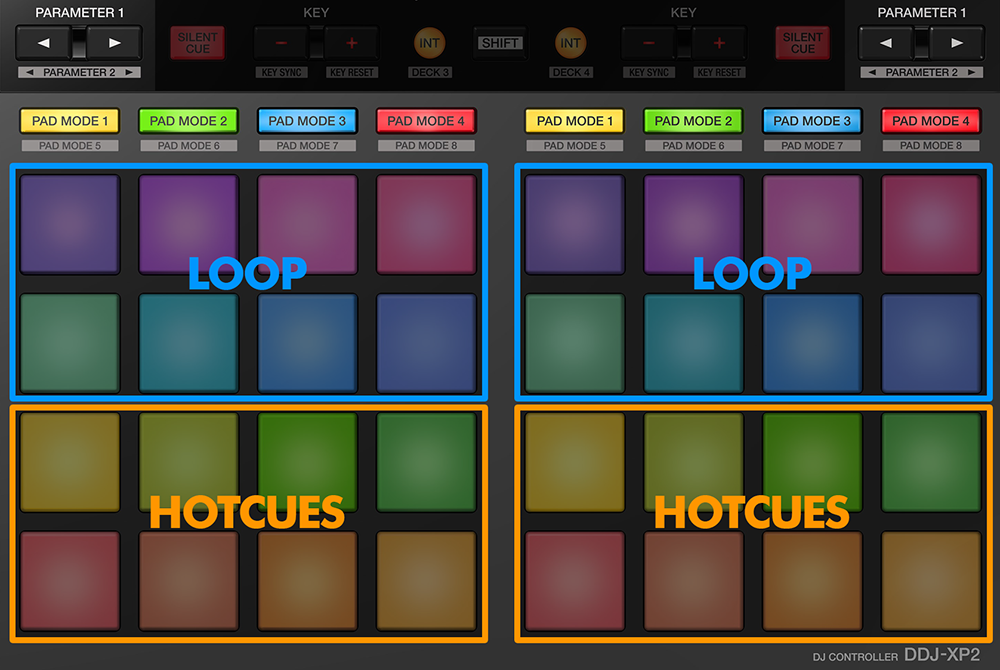
Press one of the 8 upper pads to trigger an automatic loop of a different size in beats, depending on the selected page. There are 6 different pages available with sizes starting from 1/32 up to 128 beats.
Press one of the 8 lower pads to assign a Hot Cue Point (1 to 8) or to jump the track to that Hot Cue Point (if assigned).
Use the PARAMETER buttons to select the previous/next page with the desired Loop sizes for the Auto Loop section.
Hold SHIFT button down and then use the PARAMETER buttons to change the behavior of the Loop pads, by selecting the On/Off (toggle), Hold (momentary – while pad is pressed) or the Roll mode (track will resume to the position it would have been once the pad is released)
BEATJUMP & HOTCUES
Hold SHIFT button down and then press the PAD MODE 2 button to set the PADs to Beatjump & Hotcues mode.
In this mode the pads of each deck are divided to two groups:
The upper two rows (pads 1-8) operate Beat Jumps, and the lower two rows (pads 9-16) operate the Hotcues.
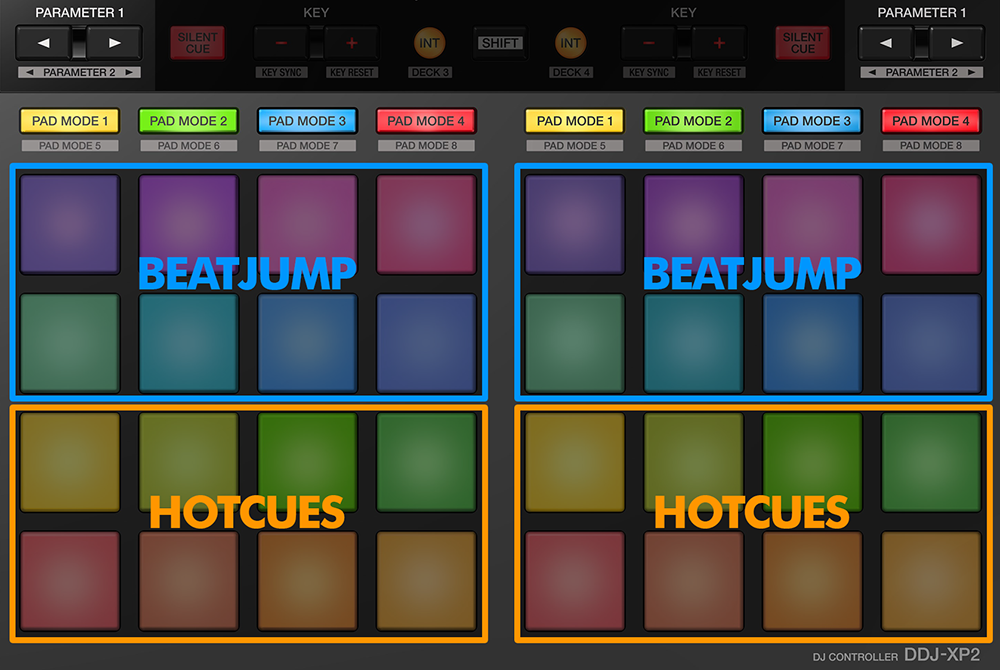
Press one of the 8 upper pads to jump the track backwards/forward by a different amount of beats depending on the selected page/bank (from 1/8 beats to 32 bars)
Press one of the 8 lower pads to assign a Hot Cue Point (1 to 8) or to jump the track to that Hot Cue Point (if assigned).
Use the PARAMETERS buttons to select the previous/next page with the desired Beats sizes
KEYCUE
Hold SHIFT button down and then press the PAD MODE 3 button to set the PADs to Keycue mode.
In this mode each of the 16 pads triggers a selected Hotcue point (or the Temporary Cue if none selected or not available) at a selected Key semitone (from -7 to +7).
8 different pages/banks are offered with various semitone values to use and a 0 value (reset key to its original value) is always offered in all pages.
Hold SHIFT button down and then select a Hotcue for the Key pads to trigger. Each time a pad is pressed, the track will jump to that Hotcue point and will also alter the Key of the track to the value designated by it assigned value.
Use the PARAMETER buttons to adjust the Key of the track without trigger a Hotcue.
Hold SHIFT button down and use the PARAMETER buttons to select a different page/bank with different key semitone values.
TRANSPORT
Hold SHIFT button down and then press the PAD MODE 4 button to set the PADs to Transport mode.
In this mode the pads of each deck are divided to two groups:
The upper two rows (pads 1-8) operate various transport (playback) controls, and the lower two rows (pads 9-16) operate the Hotcues.
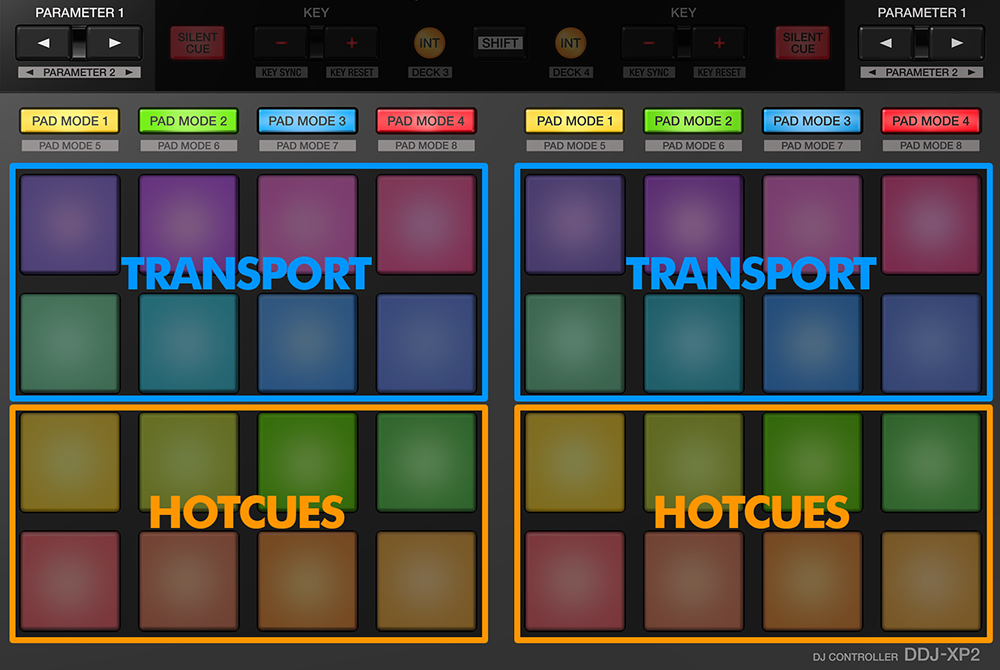
Press one of the 8 upper pads to operate an action as described on the following table:
PAD
ACTION
+SHIFT
Press one of the 8 lower pads to assign a Hot Cue Point (1 to 8) or to jump the track to that Hot Cue Point (if assigned).
